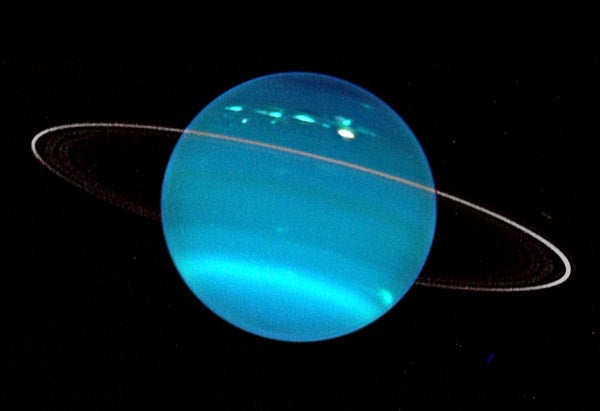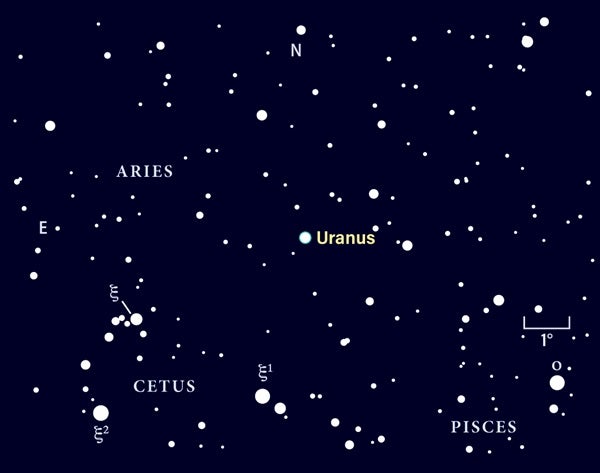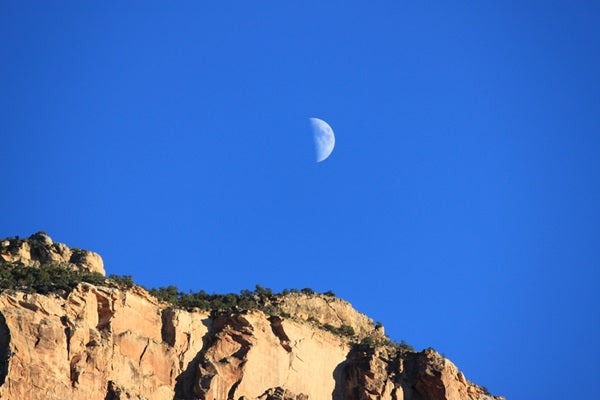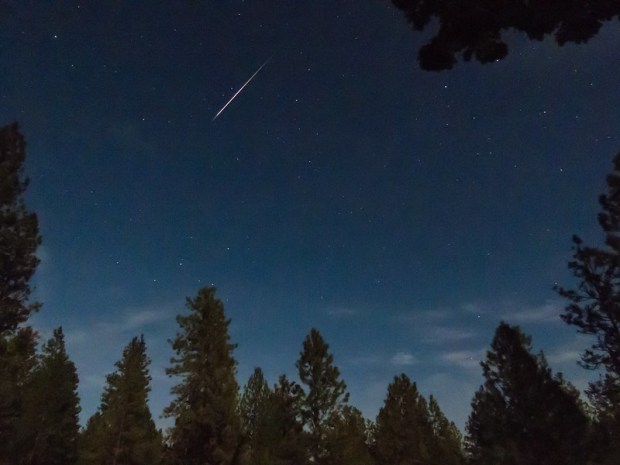A lone bright star now hangs low in the south at midevening. First-magnitude Fomalhaut — often called “the Solitary One” — belongs to the constellation Piscis Austrinus the Southern Fish. From mid-northern latitudes, it climbs 20° above the horizon at its best. How solitary is Fomalhaut? The nearest 1st-magnitude star to it, Achernar at the southern end of Eridanus the River, lies some 40° away.
Saturday, October 26
Skywatchers can get an early view of Comet PanSTARRS (C/2017 T2) this week. The visitor from the outer solar system currently glows at 11th magnitude, bright enough to spot through 6-inch or larger telescopes from under a dark sky. It lies in the constellation Auriga the Charioteer, which rises in early evening and climbs nearly overhead during the wee hours. For the next three nights, you can find it within 1° of the sparkling star cluster M36, close enough that they appear in the same low-power field of view. If predictions hold true, Comet PanSTARRS should become a nice binocular object next spring.
The Moon reaches perigee, the closest point in its orbit around Earth, at 6:39 a.m. EDT. It then lies 224,508 miles (361,311 kilometers) away from us.
Uranus reaches opposition and peak visibility tonight. Opposition officially arrives at 4 a.m. EDT on the 28th, when the outer planet lies opposite the Sun in our sky. This means it rises at sunset, climbs highest in the south around 1 a.m. local daylight time, and sets at sunrise. (From 40° north latitude, Uranus peaks at an altitude of 63°, the highest it has appeared at opposition since February 1962.) The magnitude 5.7 planet lies among the background stars of southern Aries. In the nights around opposition, you can find it 3° south-southwest of the similarly bright star 19 Arietis.. Although Uranus shines brightly enough to glimpse with the naked eye under a dark sky, use binoculars to locate it initially. A telescope reveals the planet’s blue-green disk, which spans 3.7″. To learn more about viewing Uranus and its outer solar system cousin, Neptune, see “Observe the ice giants” in October’s Astronomy.
New Moon occurs at 11:38 p.m. EDT. At its New phase, the Moon crosses the sky with the Sun and so remains hidden in our star’s glare.
Monday, October 28
Although the Orionid meteor shower peaked last week, the shower remains active until November 7. And with the Moon now gone from the night sky, observers can expect to see a few “shooting stars” in the predawn sky. To differentiate an Orionid from a sporadic, remember that a shower meteor will appear to radiate from the northern part of the constellation Orion the Hunter.
Tuesday, October 29
The solar system’s two inner planets appear near each other in the early evening sky. Tonight, Mercury slides 3° due south (lower left) of Venus. You can find the pair with the help of a two-day-old crescent Moon. Our satellite stands 8° high 30 minutes after sunset with Venus 5° to its lower right and Mercury 6° directly below the Moon. All three objects should just fit in the field of view through 7×50 binoculars. At magnitude –3.8, Venus shines far brighter than magnitude 0.1 Mercury.
Wednesday, October 30
This week offers an excellent opportunity to view the zodiacal light. From the Northern Hemisphere, early autumn is the best time of year to observe this elusive glow before sunrise. It appears slightly fainter than the Milky Way, so you’ll need a clear moonless sky and an observing site located far from the city. Look for the cone-shaped glow, which points nearly straight up from the eastern horizon, shortly before morning twilight begins (around 6 a.m. local daylight time at mid-northern latitudes). The Moon remains out of the morning sky until November 11, when its bright light will return and overwhelm the much fainter zodiacal light.
Thursday, October 31
Use the waxing crescent Moon as a guide to finding Jupiter in the southwestern sky this evening. You can find Jupiter 5° to Luna’s lower right as darkness falls. Of course, Jupiter is on display all week. It shines at magnitude –1.9 and dominates the early evening sky from its perch in southern Ophiuchus the Serpent-bearer. When viewed through a telescope, Jupiter shows a 33″-diameter disk with striking details in its dynamic atmosphere. You also should see four bright points of light arrayed around the planet: the Galilean moons Io, Europa, Ganymede, and Callisto.
Friday, November 1
The Moon moves about 13° eastward relative to the background stars each day, and this movement carries it into Saturn’s vicinity this evening. Look for the ringed planet 4° to Luna’s upper left. As with Jupiter, Saturn remains a glorious sight all week. The ringed planet resides among the background stars of Sagittarius the Archer, a region that appears 20° high in the southwest as twilight fades to darkness and doesn’t set until 10 p.m. local daylight time. Saturn shines at magnitude 0.6 and appears significantly brighter than any of its host constellation’s stars. Although a naked-eye view of the planet is nice, seeing it through a telescope truly inspires. Even a small instrument shows the distant world’s 16″-diameter disk and spectacular ring system, which spans 36″ and tilts 25° to our line of sight.
Saturday, November 2
After a three-month hiatus, Mars returns to view before dawn this week. You can find it 8° above the eastern horizon an hour before the Sun rises. The Red Planet shines at magnitude 1.8 and should be obvious through binoculars. Once you find the ruddy world, try to spot it with just your naked eye.
A nearly First Quarter Moon appears high in the south as darkness falls and remains on view until after 10 p.m. local time. Our satellite officially reaches its First Quarter phase at 5:23 a.m. EST tomorrow morning, so it looks a little less than half-lit this evening. It will appear slightly more than 50 percent illuminated tomorrow night. The Moon spends this evening lies among the background stars of Capricornus the Sea Goat.
For those areas of the United States and Canada that observe daylight saving time, set your clocks back one hour this morning. The official switch occurs at 2 a.m. local daylight time, which becomes 1 a.m. local standard time. The switch means sunrise and sunset both arrive an hour earlier today than they did yesterday. So, at least by clock time, the latest sunrise of the year occurred yesterday morning.












